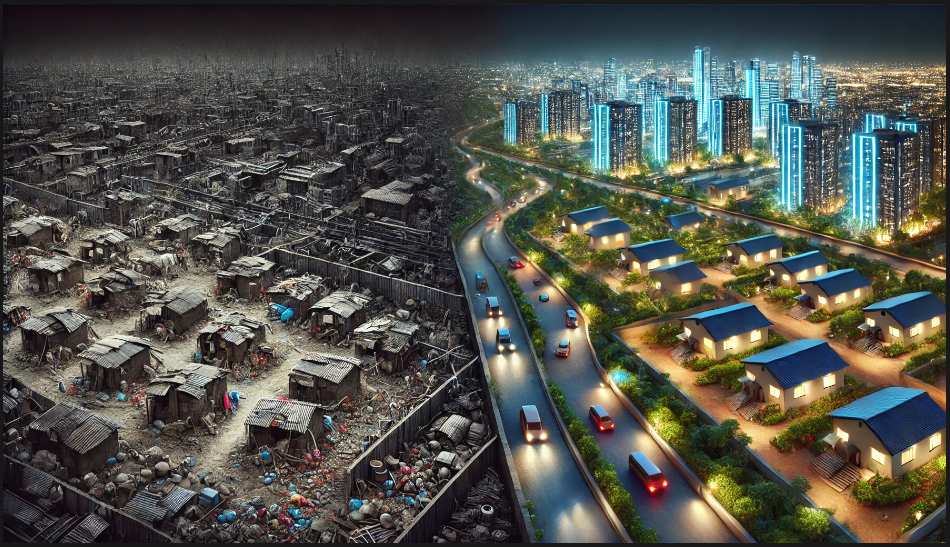Introduction
Slums are an integral part of urbanization, housing millions of people in conditions of extreme poverty, inadequate infrastructure, and lack of basic civic amenities. With rapid urbanization, particularly in developing countries, slums have expanded, creating challenges related to sanitation, healthcare, water supply, housing, and education. Effective urban planning plays a crucial role in improving the living standards of slum dwellers by ensuring the development of sustainable and well-integrated civic amenities. This article examines the significance of urban planning in enhancing basic services in slums and outlines strategies for inclusive urban development.
Understanding Slums and Their Challenges
Slums are characterized by overcrowding, poor housing conditions, lack of proper sanitation, and limited access to essential services. The primary challenges faced by slum dwellers include:
- Inadequate Housing: Poorly constructed homes made from fragile materials, lacking stability and safety.
- Lack of Clean Water Supply: Many slums have no direct access to clean drinking water, leading to health issues.
- Poor Sanitation and Waste Management: Open defecation, poor drainage systems, and the accumulation of waste contribute to unhygienic conditions.
- Limited Healthcare Facilities: The absence of proper healthcare infrastructure leads to the spread of diseases.
- Poor Transportation and Infrastructure: Slums often develop in unauthorized areas with limited access to roads and public transport.
- Unemployment and Economic Hardship: Slum dwellers face difficulties in securing stable jobs due to low education levels and lack of opportunities.
The Role of Urban Planning in Slum Development
Urban planning provides a framework for systematically improving slums by incorporating them into the larger urban fabric. It focuses on infrastructure development, spatial organization, and policy-driven interventions. The key aspects of urban planning that contribute to the development of civic amenities in slums include:
1. Provision of Adequate Housing
Urban planning helps design and implement affordable housing programs to replace unsafe structures with durable housing units. Strategies include:
- Slum Upgradation Projects: Governments and private sectors collaborate to improve existing slum housing with better materials and infrastructure.
- Low-Cost Housing Schemes: Construction of affordable housing for slum dwellers, ensuring tenure security.
- In-Situ Rehabilitation: Instead of relocating slum dwellers, improving their existing living spaces with better facilities.
2. Improvement in Water Supply and Sanitation
A critical aspect of urban planning is the development of water supply and sanitation systems to enhance hygiene and reduce diseases.
- Installation of Public Water Facilities: Providing communal water taps and pipelines for clean drinking water access.
- Sanitation Infrastructure Development: Construction of community toilets, proper sewage systems, and waste disposal units.
- Rainwater Harvesting: Implementing sustainable water management solutions to reduce dependency on unreliable sources.
3. Healthcare and Public Health Interventions
Slum residents often lack access to medical services, making healthcare infrastructure a priority.
- Mobile Health Clinics: Deploying mobile medical units to provide healthcare at accessible locations.
- Community Health Centers: Establishing low-cost clinics for basic medical services and maternal care.
- Vaccination and Disease Prevention Programs: Conducting awareness campaigns and vaccination drives to combat common diseases.
4. Transportation and Connectivity
Improving road networks and public transportation is crucial for integrating slums into the broader urban economy.
- Development of Access Roads: Creating better pathways and roads for ease of movement.
- Public Transport Inclusion: Expanding bus and metro services to reach slum areas, improving employment accessibility.
- Pedestrian-Friendly Infrastructure: Constructing safe walkways and cycle tracks to encourage alternative commuting options.
5. Waste Management and Environmental Sustainability
Slums often struggle with waste accumulation and pollution due to the absence of structured waste management.
- Community Waste Collection Programs: Organizing regular waste collection and disposal initiatives.
- Recycling and Composting Projects: Encouraging eco-friendly waste management solutions within slum communities.
- Green Spaces and Urban Gardens: Creating small parks and community gardens to improve environmental conditions and provide recreational spaces.
6. Economic Empowerment and Skill Development
Providing employment opportunities and vocational training helps uplift slum dwellers economically.
- Skill Development Centers: Establishing training facilities for vocational education such as tailoring, carpentry, and electrical work.
- Microfinance and Entrepreneurship Support: Enabling slum residents to start small businesses through financial assistance.
- Job Creation through Urban Development Projects: Employing slum dwellers in infrastructure projects, creating direct and indirect employment opportunities.
7. Education and Community Development
Education is a powerful tool for breaking the cycle of poverty in slum communities.
- Building Schools and Learning Centers: Increasing access to education through affordable public schools.
- Scholarships and Free Educational Programs: Providing financial aid and incentives to encourage school attendance.
- Community Engagement Initiatives: Encouraging residents to participate in decision-making processes related to their development.
Case Studies: Successful Urban Planning Interventions in Slums
Several cities around the world have implemented urban planning models that successfully improve slum conditions:
- Mumbai, India – Dharavi Redevelopment Project: A model for in-situ slum rehabilitation that focuses on providing permanent housing and basic amenities.
- Kibera, Kenya – Slum Upgradation Program: Public-private partnerships have led to better sanitation and infrastructure development.
- Rio de Janeiro, Brazil – Favela Bairro Program: Focused on integrating slums into the city through road expansion, housing improvement, and social programs.
Challenges and Future Directions
Despite urban planning efforts, challenges remain in implementing large-scale improvements in slums:
- Funding Constraints: Governments often lack the resources to finance large-scale slum improvement projects.
- Political and Bureaucratic Hurdles: Slow decision-making processes delay project implementation.
- Resistance to Relocation: Many slum dwellers prefer informal settlements due to affordability and community ties.
- Climate Change Impact: Slums are highly vulnerable to environmental hazards such as flooding and extreme temperatures.
To address these challenges, future urban planning must incorporate:
- Public-Private Partnerships: Engaging businesses and NGOs in slum development projects.
- Smart City Integration: Leveraging technology to improve infrastructure and service delivery.
- Sustainable Urban Policies: Prioritizing eco-friendly solutions for long-term resilience.
Conclusion
Urban planning plays a vital role in enhancing the quality of life in slums by providing basic civic amenities and integrating informal settlements into the broader urban framework. Through strategic interventions in housing, sanitation, healthcare, education, and economic empowerment, slum conditions can be significantly improved. While challenges exist, innovative planning solutions and collaborative efforts between governments, private sectors, and communities can lead to sustainable urban development. The transformation of slums into livable, productive spaces is essential for achieving inclusive urban growth and social equity.




